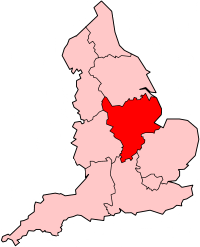Crewe to Derby Line
| Crewe to Derby Line | |
|---|---|
|
Class 170 Turbostar at Longton | |
| Overview | |
| Type | Heavy Rail |
| System | National Rail |
| Status | Operational |
| Locale |
East Midlands North West England West Midlands |
| Termini |
Crewe Derby |
| Stations | 11 |
| Operation | |
| Opened | 1848 |
| Owner | Network Rail |
| Operator(s) |
East Midlands Trains London Midland Northern Rail |
| Rolling stock |
Class 153 "Super Sprinter" Class 156 "Super Sprinter" Class 158 "Express Sprinter" |
| Technical | |
| Number of tracks | Two, One |
| Track gauge | 1,435 mm (4 ft 8 1⁄2 in) standard gauge |
| Electrification |
25 kV 50hz AC OHLE (Stoke-on-Trent to Crewe) |
| Operating speed | 70 mph (110 km/h) |
Crewe to Derby Line | |||||||||||||||||||||||||||||||||||||||||||||||||||||||||||||||||||||||||||||||||||||||||||||||||||||||||||||||||||||||||||||||||||||||||||||||||||||||||||||||||||||||||||||||||||||||||||||||||||||||||||||||||||||||||||||||||||||||||||||||||||||||||||||||||||||||||||||||||||||||||||||||||
|---|---|---|---|---|---|---|---|---|---|---|---|---|---|---|---|---|---|---|---|---|---|---|---|---|---|---|---|---|---|---|---|---|---|---|---|---|---|---|---|---|---|---|---|---|---|---|---|---|---|---|---|---|---|---|---|---|---|---|---|---|---|---|---|---|---|---|---|---|---|---|---|---|---|---|---|---|---|---|---|---|---|---|---|---|---|---|---|---|---|---|---|---|---|---|---|---|---|---|---|---|---|---|---|---|---|---|---|---|---|---|---|---|---|---|---|---|---|---|---|---|---|---|---|---|---|---|---|---|---|---|---|---|---|---|---|---|---|---|---|---|---|---|---|---|---|---|---|---|---|---|---|---|---|---|---|---|---|---|---|---|---|---|---|---|---|---|---|---|---|---|---|---|---|---|---|---|---|---|---|---|---|---|---|---|---|---|---|---|---|---|---|---|---|---|---|---|---|---|---|---|---|---|---|---|---|---|---|---|---|---|---|---|---|---|---|---|---|---|---|---|---|---|---|---|---|---|---|---|---|---|---|---|---|---|---|---|---|---|---|---|---|---|---|---|---|---|---|---|---|---|---|---|---|---|---|---|---|---|---|---|---|---|---|---|---|---|---|---|---|---|---|---|---|---|---|---|---|---|---|---|---|---|---|---|---|---|---|---|---|
Legend
| |||||||||||||||||||||||||||||||||||||||||||||||||||||||||||||||||||||||||||||||||||||||||||||||||||||||||||||||||||||||||||||||||||||||||||||||||||||||||||||||||||||||||||||||||||||||||||||||||||||||||||||||||||||||||||||||||||||||||||||||||||||||||||||||||||||||||||||||||||||||||||||||||
The Crewe to Derby Line is a railway line in central and North West England, running from Crewe south east to Derby via Stoke-on-Trent and Uttoxeter. Services on the line are provided by East Midlands Trains.
History
This line was opened by the North Staffordshire Railway Company and became part of the London Midland and Scottish Railway in 1923.
The line was opened between Stoke and Uttoxeter on 7 August 1848. The next stage from here to Tutbury was opened 11 September 1848. Just beyond Tutbury was formerly a branch line to Burton upon Trent, having opened on the same date, but now closed.
A separate company, the Cheadle Railway Company, built a line from Cresswell to Cheadle, which was opened throughout on 1 January 1901 and was closed to passengers in 1953 and to freight traffic in 1978.
The section of line between Egginton and the Midland Railway Derby to Birmingham line was opened on 13 July 1849. The section between Stoke and Kidsgrove is part of the West Coast Main Line, which together with the section from Kidsgrove to Crewe opened on 9 October 1848.
When Central Trains were awarded the franchise for the line in the 1990s, the Crewe-Derby service (which under BR Regional Railways had run between Crewe, Derby and Nottingham then either Lincoln or Skegness) was expanded to run between Manchester Airport and Skegness. However, poor punctuality meant that this was later curtailed to Crewe-Skegness. In Autumn 2005, further poor performance saw the through service limited to Crewe-Derby.
During 2003 much of the line was closed as part of the West Coast Main Line upgrade with trains terminating at Blythe Bridge and a shuttle bus service running between there and Crewe. After the closure all stations on the route reopened except Etruria which was closed in 2005.[1] As a result of the upgrade the section from Crewe to Kidsgrove was electrified for use as a diversionary route for the West Coast Main Line.
Stations
All stations on the route except Stoke-on-Trent and Crewe are managed by East Midlands Trains.
The line serves or has formerly served the following places (highlighted place names currently have a station whereas the others formerly had a named station that is now closed):
Crewe; Radway Green and Barthomley; Alsager; Kidsgrove; Chatterley; Longport; Etruria; Stoke-on-Trent; Fenton; Longton; Normacot; Meir; Blythe Bridge; Cresswell; Leigh; Bramshall; Uttoxeter; Marchington; Sudbury; Scropton; Tutbury and Hatton; Egginton; Pear Tree and Normanton; and Derby.
Route
The route starts at Derby and follows the route of the Cross Country Route as far as North Staffordshire Junction in Willington. the line then carries along the main body of the line until Stoke Junction on the Stoke-on-Trent branch of the West Coast Main Line until Kidsgrove where it then follows the Alsager branch as far as Crewe south junction before terminating at Crewe.
The route is double track for all of its length except for a three-mile section between Alsager and Crewe, which was singled by British Rail. Whilst the majority of the route is not electrified, the section between Stoke Junction and Crewe is as this is a part of the West Coast Main Line.
In April 2006, Network Rail organised its maintenance and train control operations into "26 Routes". The line from Crewe to Kidsgrove (where it joins the line from Manchester) through to Stoke-on-Trent forms part of Route 18 (The West Coast Main Line). The line through to Derby from the junction just south of Stoke-on-Trent station forms part of Route 19 (The Midland Main Line and East Midlands).
Services
The line sees a basic hourly service in each direction with trains calling at all stations on the route however Peartree which is served by 2 Derby bound trains and 3 Crewe bound trains per weekday.
The majority of services on the route since December 2008 have been provided by Class 153 "Super Sprinter" Diesel Multiple Units however Class 158 "Express Sprinter" and Class 156 "Super Sprinter" units are occasionally used. Overcrowding remains a major issue on the route, particularly in the morning and evening peak and a weekends. Passengers are occasionally left behind.[2]
Future
Network Rail in their East Midlands Route Utilisation Strategy has proposed extending the service to Nottingham.
References
- ↑ "Last train departs from station". BBC News. 30 September 2005. Retrieved 27 September 2012.
- ↑ "Race-goers fight for space on train". This is Staffordshire. 4 May 2009. Retrieved 6 January 2013.
| Wikimedia Commons has media related to Crewe to Derby Line. |





